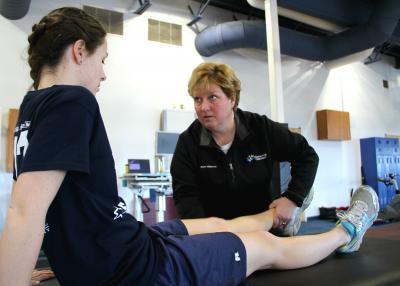Basketball is a popular high school sport in the United States with 1 million participants annually. A recently published study by researchers in the Center for Injury Research and Policy at Nationwide Children's Hospital is the first to compare and describe the occurrence and distribution patterns of basketball-related injuries treated in emergency departments and the high school athletic training setting among adolescents and teens.
The study, published online in the Journal of Athletic Training, examined data relating to adolescents 13-19 years of age who were treated in U.S. emergency departments (EDs) from 2005 through 2010 and those treated in the high school athletic training setting during the 2005—2006 through the 2010—2011 academic years for an injury associated with basketball. Nationally, 1,514,957 patients with basketball-related injuries were treated in EDs and 1,064,551 were treated in the athletic training setting.
The study found that in general, injuries that are more easily diagnosed and treated, such as sprains/strains, were more likely to be treated onsite by an athletic trainer while more serious injuries, such as fractures, that require more extensive diagnostic and treatment procedures were more commonly treated in an ED.

Because fewer than half of all high schools in the US have athletic trainers on staff, the majority of those injured players were treated in emergency departments, often unnecessarily. Researchers are calling for the use of more athletic trainers who can more efficiently care for injured athletes and help them rehab their injuries safely. Credit: Nationwide Children's Hospital)
"Athletic trainers play a really important role in helping to assess those more mild or moderate injuries and that helps alleviate a burden on the health care system and on families," said Lara McKenzie, PhD, the study's lead author and principal investigator in the Center for Injury Research and Policy at Nationwide Children's. "They are right there on the sidelines. They are there when some of these things happen. And they can be a great resource for families to evaluate that injury immediately."
In 1998, the American Medical Association recommended all high school sports programs enlist an athletic medicine unit consisting of a physician director and an athletic trainer, yet as of 2009, the National Athletic Trainers' Association estimated only 42 percent of high school sports teams met this recommendation. With more than half of U.S. high school athletes not having access to an athletic trainer during practice or competition, a vast majority of injured players wind up in urgent care facilities and emergency departments, some unnecessarily
Dr. McKenzie, also a faculty member at The Ohio State University College of Medicine, said that while athletic trainers cannot treat every injury, they can make the system more efficient by only sending athletes to the hospital when it is necessary and helping athletes return to play when it is safe.
"We are there to prevent injuries, evaluate them quickly, treat them immediately and try our best to make sure that as we return them to play we do it in the most safe and efficient way possible," said Kerry Waple, ATC, certified athletic trainer in Sports Medicine at Nationwide Children's. "There are a lot of injuries that happen that are winding up in urgent cares and emergency departments that don't need to be there."
The Sports Medicine team at Nationwide Children's partners with 13 high schools across central Ohio and provides on-site certified athletic trainers for athletes during both practice and competition. The athletic trainers provide immediate triage, diagnosis and treatment to injured athletes and help them return to play safely and at the right time. In addition, Nationwide Children's Sports Medicine experts provide injury prevention techniques to high school and middle school athletes.
Data for this study were obtained from the National Electronic Injury Surveillance System (NEISS), which is operated by the U.S. Consumer Product Safety Commission. The NEISS database provides information on consumer product-related and sports- and recreation-related injuries treated in hospital emergency departments across the country. Data for this study were also obtained from the High School Reporting Information Online™ database.
A new study about injuries to high school basketball players has experts calling for some changes on the sidelines before next season. Researchers at Nationwide Children's Hospital studied injuries between 2005-2011 in the US and found that more than 2.5 million high school basketball players were injured and there aren't nearly enough athletic trainers were in schools to care for them. Credit: Nationwide Children's Hospital)Source: Nationwide Children's Hospital